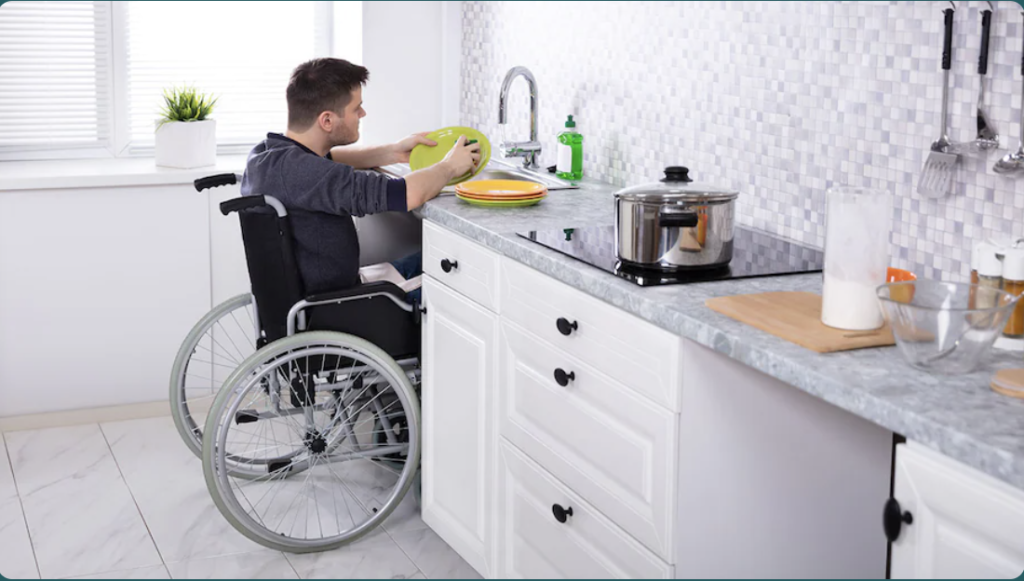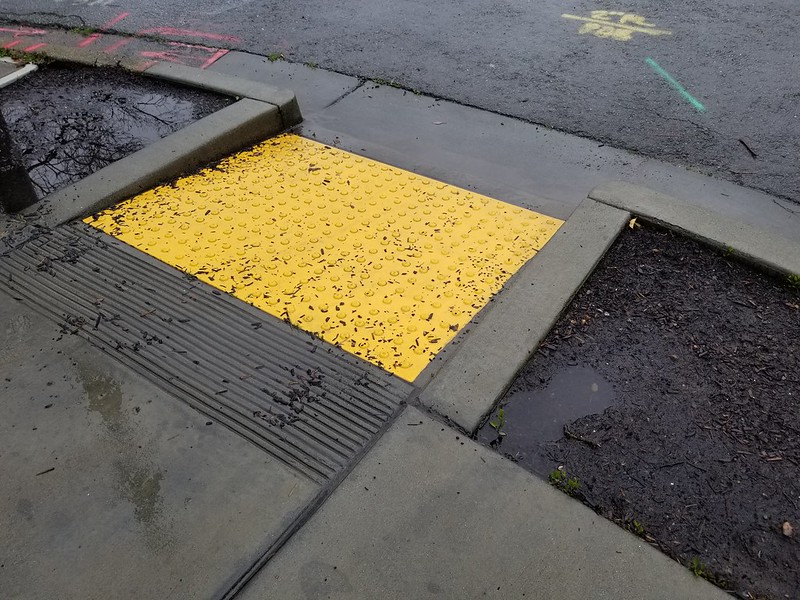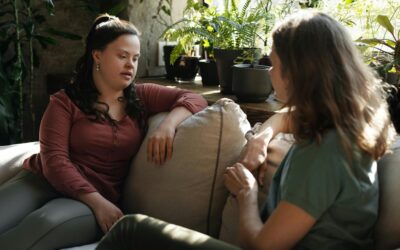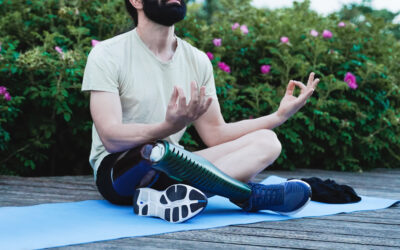(Image: Someone grabs a handrail in a bathroom, one component of Universal Design in the home.)
In today’s world, where diversity is valued and inclusion is a priority, creating spaces that cater to everyone’s needs is no longer a nicety, but a necessity. This is where Universal Design (UD) comes in – a philosophy and practice that aims to design environments and products that are usable by people of all ages, abilities, and sizes. Universal Design is the concept of creating environments that can be accessed, understood, and used to the greatest extent possible by everyone, regardless of their age, size, ability or disability.
UD originated in architecture, championing the idea of making living spaces accessible to everyone. However, over the years, the ideas has also migrated into products, technology and systems, with the aim of increasing accessibility for all, regardless of ability. Following, we’ll take a look at each category.
Creating Homes for Everyone: The Power of Universal Design in Living Spaces
Imagine a home – not just any home, but a comfortable, functional space that welcomes everyone, regardless of age, ability, or size. This is the vision behind UD for living spaces. UD is the concept of designing homes that can be accessed, understood, and used to the greatest extent possible by everyone. It moves beyond basic functionality to create environments that are inclusive and empowering for all residents.
Why Universal Design Matters at Home
UD isn’t just about accessibility for people with disabilities. It’s about creating a future-proof living space that adapts to your needs as you age or your family circumstances change. Here’s how UD benefits everyone:
• Safety and Independence: UD features like wider doorways, grab bars in bathrooms, and easy-reach controls in kitchens promote safety and independence for people of all ages and abilities.
• Flexibility and Comfort: UD prioritizes adaptable spaces. Think open floor plans, adjustable countertops, and removable showerheads. This allows residents to personalize their living space for maximum comfort.
• Livability for All: UD fosters a sense of belonging and togetherness. Everyone, from grandparents to young children, can navigate and participate in activities within the home.
• Increased Use Value: A UD home is not just livable, it’s also a smart investment. Homes with UD features can be used by future owners without needing major renovations.

A man who is a wheelchair user washes dishes in his home at a sink and counter space that is lower for accessibility.
Bringing UD to Life: Examples in Your Home
UD principles can be incorporated into various aspects of your living space. Here are some examples:
• Entrance and Hallways: Ensure a wide entryway (at least 36 inches) to accommodate wheelchairs and walkers. Opt for lever door handles instead of knobs for easier opening.
• Kitchen Design: Prioritize clear circulation space, with ample room to maneuver between appliances. Lower cabinet shelves and install pull-out drawers for easier access.
• Bathroom Transformations: Incorporate grab bars near the toilet and shower for added support. Consider a walk-in shower with a built-in seat for safety.
• Lighting and Controls: Install dimmer switches for adjustable lighting. Use rocker-style light switches that are easier to operate for everyone.
• Flooring: Opt for slip-resistant flooring throughout the house to minimize the risk of falls. Consider low-pile carpets or throw rugs that lay flat to avoid tripping hazards.
More Specific Applications
Some proponents of UD advocate for flexible features, such as countertops that can be raised or lowered, in order to accommodate wheelchair users or others height-reach barriers. And today, technology can serve to support accessibility with things like voice activated lights and other appliances. There is a tremendous amount of knowledge, technology, and opportunity today to build living spaces in a way that makes them accessible, comfortable, and beautiful for everyone.
Universal Design is not an unattainable ideal; it’s a practical approach to creating homes that work for everyone. By embracing UD principles, we can invest in living spaces that foster comfort, safety, and inclusivity for all residents, now and in the future.
Beyond Housing
While UD has it’s roots in building and architecture, it has expanded to include other applications from product design, to technology, to services. At its heart, UD is about designing products, environments, and systems with the broadest range of users in mind. Pioneered by Ronald Mace, UD is guided by seven key principles:
• Equitable Use: The design caters to individuals with diverse abilities, making it usable and appealing to everyone.
• Flexibility in Use: The design accommodates a wide range of individual preferences and capabilities.
• Simple and Intuitive Use: The design is easy to understand, regardless of a user’s experience, knowledge level, or current focus.
• Perceptible Information: Essential information is effectively communicated through the design, considering ambient conditions and users’ sensory abilities.
• Tolerance for Error: The design minimizes hazards and the negative consequences of accidental actions.
• Low Physical Effort: The design can be used efficiently and comfortably with minimal fatigue.
• Size and Space for Approach and Use: Adequate space is provided for navigation, reach, manipulation, and use, regardless of a user’s body size, posture, or mobility.
Why Universal Design Matters

A curb cut painted in yellow makes the use of public sidewalks more accessible for everyone.
The benefits of UD extend far beyond individuals with disabilities, impacting society as a whole. Here’s how:
• Inclusion: UD fosters a sense of belonging by ensuring everyone can participate fully in society, regardless of limitations. It breaks down barriers and creates inclusive spaces.
• Accessibility: By making spaces and products accessible to a wider range of users, UD enhances convenience and usability for everyone. Public spaces, transportation systems, and digital interfaces become more user-friendly.
• Future-Proofing: Designing with UD principles in mind creates future-proof environments and products. As demographics shift and populations age, the need for accessible and user-friendly designs will only increase.
• Social and Economic Advantages: Accessible spaces and products empower people with disabilities to actively participate in the workforce, education, and community life. This contributes to economic growth and social cohesion.
• Ethical Imperative: Inclusivity is a fundamental human right. Embracing UD reflects a commitment to equality, dignity, and respect for all individuals, regardless of their differences.
UD in Action: Real-World Examples
UD is not just a theoretical concept; it’s a practical approach with real-world applications. Here are some examples:
• Curb Cuts: Originally designed for those with mobility limitations, curb cuts benefit everyone from parents pushing strollers to travelers with luggage, and even cyclists.
• Smartphone Accessibility Features: Features like voice recognition, screen readers, and haptic feedback make smartphones usable by people with visual or hearing impairments, as well as those with dexterity limitations.
• Flexible Furniture: Adjustable-height desks, modular seating arrangements, and ergonomic chairs cater to diverse body types and preferences in educational and office settings.
• Accessible Transportation: Public transportation systems with features like ramps, priority seating, and audible announcements benefit not only passengers with disabilities and older adults, but also parents with young children and travelers with luggage.
• Universal Design in Digital Interfaces: Websites and mobile applications that incorporate accessibility features like text resizing options, alternative text descriptions for images, and keyboard shortcuts ensure that everyone can access and navigate digital content.
The Road Ahead: Building a More Inclusive World
Universal Design is not a mere aspiration, but a practical approach to creating inclusive environments that enrich the lives of all individuals. By embracing the principles of UD, designers, architects, policymakers, and businesses can contribute to a more accessible, equitable, and compassionate society. Let’s move forward with the understanding that designing for everyone is not just good practice, it’s the right thing to do.





